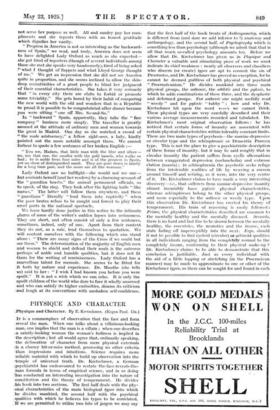PHYSIQUE AND CHARACTER
,Physique and Character. By E. Kretschmer. (Kegan Paul. 15s.) IT is a commonplace of observation that the face and form reveal the man. When one talks about a villainous-looking man, one implies that the man is a villain ; when one describes- a saintly-looking woman the woman's holiness is implied in the description ; but all would agree that, ordinarily speaking, the delineation of character from mere physical externals lis a chancy hit-or-miss method, possessing no other criteria than impressions and intuitions. Science requires more reliable material with which to build up observation into the 'temple of universal truth. Dr. Kretschmer, a German psychiatrist has endeavoured to restate the-face-reveals-the- ; man formula in terms of empirical science, and in so doing has conducted an interesting investigation into the nature of constitution and the theory of temperament. He divides t his book into two sections. The first half deals with the phy- sical characteristics of the main biological types into which he divides mankind, the second half with the psychical qualities with which he believes his types to be correlated. U we are permitted to utilize two bits of jargon we may say that the first half of the book treats of Anthropometry, which is different from (and dare we add inferior to ?) anatomy and anthropology, and the second half, of Psychography which is something less than psychology (although we admit that that is all that much so-called psychology amounts to). Before we allow that Dr. Kretschmer has given us in Physique and Character a valuable and stimulating piece of work we must indicate its chief weakness : nearly all observers and classifiers who discern (or create) types are apt to commit the sin of Procrustes, and Dr. Kretschmer has proved no exception, for he cannot be deemed guiltless of both physical and psychical " Procrustea.nism." He divides mankind into three main physical groups, the asthenic, the athletic and the pyknic, to which he adds combinations of these three, and the dysplastic and deformed groups. For asthenie one might usefully read " weedy " and for pyknic " tubby " ; how and why Dr. Kretschmer hit upon the word VI/KWh' we cannot think. These physical types are very carefully described and their various average measurements recorded and tabulated. Dr. Kretschmer's most original observation follows : he has noticed that certain forms of insanity are associated with certain physical characteristics within tolerably constant limits. There are two main types of psychosis—the maniac-depressive or circular type and the schizophrenic or Dementia Praecox type. This is not the place to give a psychiatristic description of these forms of insanity, but it may be said roughly that in circular insanity the patient suffers from cyclic alternations between exaggerated depression (melancholia) and extreme elation (mania) ; in schizophrenia the psychotic seeks refuge from the intolerable realities of life by weaving a cocoon around himself and retiring, as it were, into the very centre of it. Dr. Kretschmer claims to have made a very interesting discovery—i.e., that sufferers from maniac-depressive insanity almost invariably have pyknic physical characteristics, whereas schizophrenes belong to the other physical groups, and more especially to the asthenic or weedy type. Upon this observation Dr. Kretschmer has erected his theory of temperament. His train of reasoning is easily followed : Primo, the physical characteristics described are common to the mentally healthy and the mentally diseased. Secundo, there is no hard and fast line to be drawn between the mentally healthy, the eccentrics, the neurotics and the insane, each state fading off imperceptibly into the next. Ergo, should it not be possible to find cycloid (circular) or schizoid qualities in all individuals ranging from the completely normal to the completely insane, conforming to their physical make-up ? Dr. Kretschmer claims to be able to demonstrate that this conclusion is justifiable. Just as every individual with the aid of a little lopping or stretching (in the Procrustean manner) may be made to approximate to one or other of the Kretschmer types, so there can be sought for and found in each individual the corresponding psychic quidities, in other ivordi, we are all Cydothymes or Schizothymes. Dr. Kretschmer describes in detail the schizoid and cycloid temperaments as exemplified in ordinary men, men of genius; and men suffering from the neuroses and psychoses. It is true that we cannot detect much difference between Kretschmer's cycloid and schizoid and the extravert and introvert of other terminologists. However, Dr. Kretschmer has expressed the problem of temperament in a refreshing form, and by linking up character with physique has been able to postulate the existence of real biological types, exhibiting physical and psychical unity. It would be churlish to deny praise and thanks to anyone who seeks to reduce Particulars to Universals.
E. B. STRAUSS.











































 Previous page
Previous page